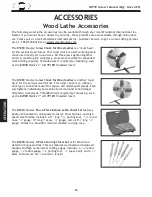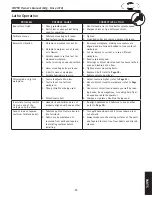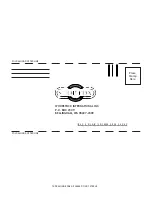
-27-
W1758 Owner's Manual (Mfg. Since 4/10)
M
A
INTE
N
A
N
CE
MAINTENANCE
Lubrication
Since all bearings for the Model W1758 are
sealed and permanently lubricated, simply
leave them alone until they need to be
replaced. Do not lubricate them.
Wipe a lightly oiled shop rag on the outside
of the headstock spindle. DO NOT allow any
oil to get on the inside mating surface of
the spindle.
Use the quill handwheel to extend the
tailstock quill all the way out, and apply
a thin coat of white lithium grease to the
outside of the quill. DO NOT allow any
lubricant to get on the inside mating sur-
face of the quill.
Cleaning the Model W1758 is relatively easy. Vacuum
excess wood chips and sawdust, and wipe off the remain-
ing dust with a dry cloth. If any resin has built up, use a
resin dissolving cleaner to remove it.
Remove any debris or oily substances from the inside of
the spindle and quill.
Cleaning
Regular periodic maintenance on your machine will
ensure its optimum performance. Make a habit of
inspecting your machine each time you use it.
Check for the following conditions and repair or
replace when necessary:
•
Loose mounting bolts.
•
Worn switch.
•
Worn or damaged cords and plugs.
•
Damaged V-belt.
•
Any other condition that could hamper the safe
operation of this machine.
General
MAKE SURE that your machine is
unplugged during all maintenance pro-
cedures! If this warning is ignored, seri-
ous personal injury may occur.
Lathe Bed
Protect the unpainted cast iron lathe bed by wiping it
clean after every use—this ensures moisture from wood
dust does not remain on the bare metal surfaces. Keep
your lathe bed rust-free with regular applications of qual-
ity lubricants.
Tailstock
To disassemble the tailstock for cleaning, loosen the set
screw above the handwheel, then completely unthread
the handwheel from the threads of the quill. Except for
the live center, thoroughly clean all of the unpainted
parts with mineral spirits and apply a thin coat of light
machine oil to these surfaces.
When re-assembling the tailstock, thread the handwheel
back onto the quill, tighten down the set screw that
secures it, then back the screw off one full turn so that
the handwheel can freely rotate.


































